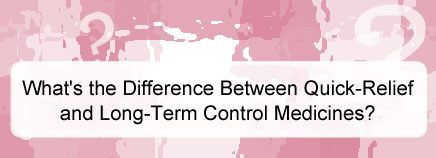
The two main types of asthma medicine are quick-relief medicines and long-term control medicines:
- Quick-relief medicines (also called rescue medicines or fast-acting medicines) work immediately to relieve asthma symptoms when they happen. They’re often inhaled directly into the lungs, where they open up the airways and relieve symptoms such as wheezing, coughing, and shortness of breath, often within minutes. But as effective as they are, these medicines don’t have a long-term effect.
- Long-term control medicines (also called controller medicines or maintenance medicines) work over a period of time to ease airway inflammation and help prevent asthma symptoms. They may be inhaled or swallowed as a pill or liquid.
Quick-Relief Medicines
The most-prescribed quick-relief medicines are quick-acting bronchodilators (usually given through an inhaler or a nebulizer), which loosen the tightened muscles around inflamed airways. The most common of these, beta2-agonists, are related to adrenaline and usually work within minutes to provide temporary relief of symptoms.
If a bronchodilator alone doesn’t resolve a severe flare-up, other medications may be given by mouth or injection to help treat it.
If your child has been prescribed rescue medication, it’s important to keep it on hand. That means at home, at the mall, at sports practice, and even on vacation.
Quick-relief medications, although an important part of asthma treatment, can be overused. Talk with your doctor about how often your child uses them. If it’s too often, the doctor also might prescribe a long-term control medicine to help prevent asthma flare-ups from happening.
Long-Term Control Medicines
Because airways can be inflamed even in between flare-ups, long-term control medicines might be needed to prevent unexpected asthma flare-ups. These slower-acting medicines can take days to weeks to start working, but when they do, they prevent airway inflammation and keep the lungs from making too much mucus.
There are a variety of long-term control medicines, but inhaled corticosteroids are the most common. They’re usually given through an inhaler or nebulizer. Despite their name, corticosteroids are not the same as performance-enhancing steroids used by athletes. They’re a safe and proven form of asthma treatment.
In fact, inhaled corticosteroids are the preferred long-term treatment for kids who have asthma symptoms often. Research shows that they improve asthma control and their risk of causing long-term negative effects is minimal. (But corticosteroids that are swallowed in liquid or pill form can cause side effects if used daily over a long period of time.)
Long-acting bronchodilators also can be used as control medicines. These relax the muscles of the airways for up to 12 hours, but can’t be used for quick relief of symptoms because they don’t start to work immediately.
Even if your child takes long-term control medicine regularly, quick-relief medicine will still be needed to handle flare-ups when they happen.
Working With the Doctor
Your doctor will decide which type of medicine your child needs based on the severity of asthma symptoms and how often they happen. Be sure to report any concerns or changes in the symptoms to help your doctor find the best treatment. Both the type and dosage of medicine needed are likely to change over time.
You play an important part in your child’s asthma treatment. For example, you can track how well the medicine is working by using a peak flow meter. You also can record information in an asthma diary and ask your doctor to create an asthma action plan, if you don’t already have one.

